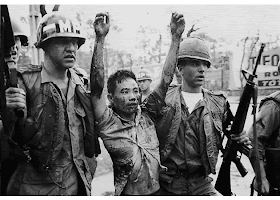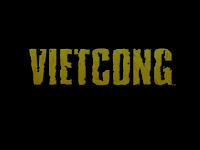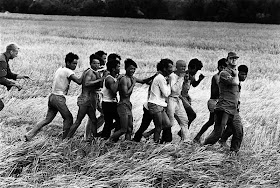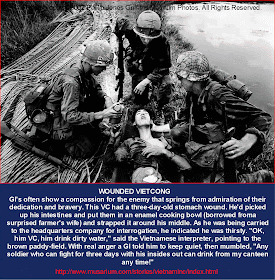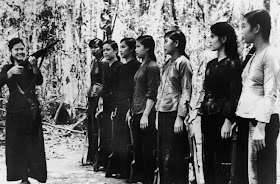How were the Vietcong and North Vietnamese Army able to defeat America with its advanced weapons in the Vietnam War?
Henry Cabot Lodge, a former American ambassador to Saigon, wrote some time after the fall of Saigon in 1975: “Was the United States engaged in an imperialist adventure far from our own shores? Or were we defending a small nation, pledged to democratic government from naked aggression? Did limitations placed on our use of military force keep us from a swift and decisive victory? Or were we engaged in a war that could not be won even with the most sophisticated and lethal weapons? Were the Vietcong freedom fighters seeking to liberate their country from centuries of foreign domination? Or were they simply terrorists, willing to use any means to gain power?
“Did the ultimate collapse of South Vietnam signify a loss of will on the part of the American people? Or were we fighting the wrong war, in the wrong place, at the wrong time? ”
Imperialist ventures, whether by America or the Europeans, were always dressed in idealistic clothes. Spain took South America’s gold in the guise of saving souls for Christianity. The French spoke of spreading civilization. The British spoke of the “White Man’s Burden.” And the Americans always talked about spreading democracy. But in the end it was always about forcing on other countries and societies what America wanted. Yes, it could find some locals whose interests coincided with its interests, but that was always secondary.
America fought in Vietnam because its power elite wanted to restrict the spread of communism. The Vietcong was fighting for independence from the corrupt regimes of South Vietnam, hence it had a well-motivated fighting force. It was also more in tune with the needs and mindset of South Vietnamese masses. America was propping up unpopular corrupt rulers in South Vietnam while the North Vietnamese power elite backed the driven Vietcong fighters. The result was inevitable.
The two main reasons why Vietcong defeated America in Vietnam are,
1. Self-evident. The Vietcong was guided and controlled by the North Vietnamese leaders and received massive arms and ideological support from Hanoi (Which had the support of both China and the Soviet Union).
2. The Vietcong was able to reach out to the masses. The American-backed South Vietnamese regimes were corrupt and failed utterly in connecting with the people.
We shall now examine how the Viet Cong was able to connect with the masses so well.
WHY WAS THE VIETCONG SO SUCCESSFUL IN GAINING POPULAR SUPPORT?
The most popular aspect of the NLF programme was the promise to take the land from the rich and to distribute it amongst the peasants. During the Indochina War the Vietminh had taken the land from the large landowners in the territory they controlled and given it to the peasants. After Diem had gained power in South Vietnam, he forced the peasants to pay for the land they had been given. This was often more than the peasants could afford and it caused a considerable amount of suffering amongst the peasant community. The promise of the NLF to give the peasants their land free of charge was an important factor in persuading them to help the guerrillas in their fight against the Diem government.
Most peasants in South Vietnam were extremely poor. For centuries, the Vietnamese peasants had accepted this state of affairs because they believed that poverty was a punishment for crimes committed by their ancestors. The NLF educated the peasants in economics and explained how poverty was the result of the landowner's selfishness. They pointed out that fifty per cent of the agricultural land in South Vietnam was owned by only two and a half per cent of the population. Two thirds of the peasants owned no land at all and were therefore forced to work for the rich landlords.
The NLF's solution to this problem was to take the property of the large landowners and distribute it amongst the peasants. In some cases, the landowners were executed as a punishment for the way they had treated the peasants in the past.
In return for the land they had been given, the peasants agreed to help the NLF by feeding and hiding them. In some cases, the peasants also agreed to take up arms with the NLF and help 'liberate' other villages.
The Vietcong code of conduct helped it gain the confidence of the Vietnamese peasants. When the NLF entered a village they obeyed a strict code of behaviour. All members were issued with a series of 'directives'. These included:"
(1) Not to do what is likely to damage the land and crops or spoil the houses and belongings of the people; (2) Not to insist on buying or borrowing what the people are not willing to sell or lend;
(3) Never to break our word;
(4) Not to do or speak what is likely to make people believe that we hold them in contempt;
(5) To help them in their daily work (harvesting, fetching firewood, carrying water, sewing, etc.)."
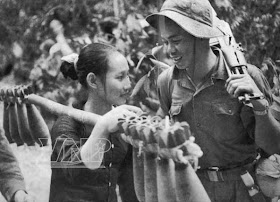 |
| Vietcong Dealt With The Masses In A "We Are One Family" Manner |
Vietcong Dealt With The Masses In A "We Are One Family" Manner
How then did it come to pass that Vietnamese peasants joined a modern revolutionary movement? The basic approach of Vietnamese peasantry was ‘live and let live’. They expected no dramatic change in their way or quality of life, and endeavored to live a traditional life based on the rice culture. Peasants did not seek adventure, preferring financial security for their family within the community. The Viet Cong knew how to use the Vietnamese tradition as means for achieving its own goals.
Opposition to the organization or support of the South Vietnamese or American governments resulted in cruel measures, and would often end in executions. Nevertheless, enlistment in the organization was translated into traditional concepts, and even included an adoption of the Vietnamese familial model. Political cadres presented themselves as the fathers of the Vietnamese nation or as its teachers. These cadres were often older individuals, while the pool of potential recruits included the younger generation. The relationship was therefore based on fear and respect, in accordance with Vietnamese tradition. Terrorism was organized, planned, and exercised only against individuals, and rarely used as means for collective punishment. Punishment of peasants who had failed to support the Viet Cong was portrayed as the reprimand of a wayward son. The punishment itself was inflicted only after a trial was held and the offences clarified for the benefit of the defendants and the villagers. Punishments were explained through traditional rather than political-ideological concepts. The crimes of condemned individuals were explained as potentially harmful to the community rather than as reflections of political opposition to the Viet Cong. Also, individuals collaborating with government forces were accused of an intention to harm peasants through anti-traditional modernization.
Video: Vietcong Weapons and tactics
OTHER FACTORS IN FAVOR OF THE VIETCONG
1. Peasants often joined the ranks of the organization that had first arrived in the village. Until 1965, joining the Viet Cong and remaining close to the family was a better option than joining the Army of the Republic of Vietnam, which had been suffering severe setbacks. In addition, army recruits were often posted in faraway battlefields.
2. Peasants whose fields were situated in territories held by the Viet Cong joined the organization in order to protect their financial interests; these actions reinforced the Viet Cong claim that joining the organization protected peasant interests.
3. Some peasants joined the organization wishing to avenge the death of a family member killed by the government or by forces allied to it. A 1967 study stated that revenge against the South Vietnamese government became more prevalent. Several individuals stated that they had joined the Viet Cong since the French harmed their families, and they could now exact their revenge. Hence, it is apparent that the governments of South Vietnam and the United States were perceived as a continuation of French rule. The government was perceived as a continuation of the hated (primarily for religious reasons) Diem regime, which had itself been perceived as a substitute for the detested French colonialists.
4. Peasants also joined the Viet Cong out of nationalist reasons. The Vietnamese sought a unification of the north and the south. However, this motivation was not based on Communist doctrine but rather on the long history of Vietnam as a nation. Cultural Vietnamese elements such as language, poetry, literature, music, and drama were more important than any political ideology or agenda.
VIDEO: The Vietcong's simple, crude but effective weapons
References
Suggested Reading
